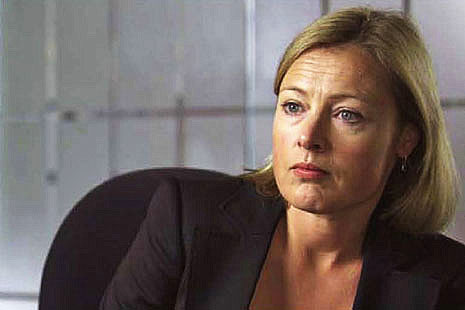THE word documentary often signals the sort of film many moviegoers will decide they don’t want to see; they’re being offered instruction, and it therefore can’t be entertainment. But the boundaries are blurred; too much of the liveliest cinema is other than mainstream feature film, and we resort to awkward constructions like “film essay.” That’s probably the best available term for Charles Ferguson’s Inside Job: film essay, film argument, film polemic; an inventive, high-energy, angry film which incites anger while offering much ironic enjoyment and fierce comedy along its path.
Tracking the global financial crisis, the film uses graphics, interviews and stunning images of Manhattan’s forested skyscrapers to consider the processes whereby a devious system of credit-swapping led to the collapse of giant institutions like Lehman Brothers, Goldman Sachs and Merrill Lynch. We watch while several masters of the universe display their breathtaking moral autism, dodging questions on the ethics of their strategies – or else, at times, appearing not to comprehend such questions at all; at those incredible moments, the audience gasps. What we can’t dodge, as the story unfolds, is that these men (there’s just one woman on that power level) didn’t really know what they were doing. Several of them got away with murder – that is, as the structures collapsed beneath them, they took tens of millions of dollars in severance money as they left, while unemployment soared across the country and thousands lost their houses. We look at one aspirational villa after another, the grass growing tall in front of them and the real-estate notices up; and as the film goes on, the Manhattan towers gather force as major symbols. Attempts by Washington to institute legislation controlling the excesses get only so far; the huge financial institutions inexplicably recover, and George Soros pronounces the awful truth: “It’s a Wall Street government.” Throughout Inside Job, cinematic pleasure carries the information content; there is horrific comedy in this tale. But anger supervenes, and so it should.
Looking back across the summer’s main offerings: wherever three or four cinephiles have been gathered round their yum-cha, there’s been disagreement about the success or failure of Peter Weir’s The Way Back. You must have a view on it; this director is still One of Our Boys, and each one of his films aspires to make it through and beyond the movies into art. And we all have our histories with him; I loved the glaring grotesqueries of The Cars that Ate Paris, loathed the gentility of Picnic at Hanging Rock, loathed even more the racist fancywork of The Last Wave and the careful conformism of Gallipoli – it was hard after those to keep the mind and eyes open for the undoubted merits of Master and Commander.
The Way Back tells a story, which might be halfway true, about the escape of six men from the brutalities of a crowded Soviet gulag, and the trek across central Asia that follows. The opening sequence in the prison is brilliant choreography; after that, the task is to find drama in endurance and survival, a sparse stringing-out of incidents in huge spaces. Early on, in snow and blizzard, one of them freezes to death. A wandering Polish girl joins them; they cover stony wastes, then sandhills, and make it through a raging dust storm; they find a well and exult in water; they deal with mosquitoes and get away from wolves; they kill and eat a snake. Two will die of heat and thirst; Ed Harris’s character, Mr Smith, will head off into Tibet; three will struggle into India.
The landscapes are huge and stunning; this film belongs most to one of the world’s great cinematographers, Russell Boyd. Weir is trying for epic poetry, and some think he attains it; but I could not find that imagery and human drama came together, despite the occasional intensity delivered by the performers. Ed Harris does his contained-bitterness number very well. Too often, the dialogue belongs to a boys’-own adventure. And even now, thirty-five years after Hanging Rock, the female element is again there to be virginal and visionary; she appears in order to vanish. It’s formulaic; put pathos and nature together, you might somehow guarantee seriousness.
In their wonderful version of True Grit, Joel and Ethan Coen grasp the kind of cinema poetry that eludes The Way Back. This version builds on the 1969 original and changes it; Jeff Bridges inherits John Wayne like a son, but Hailee Steinfeld’s Mattie, with her long, literate sentences, is a feminist creation of the present. Their penultimate ride is a lyric passage, fully earned by content. The film is still on round the place after weeks, deservedly holding audiences. So, for reasons I find hard to understand, is Black Swan, an inchoate melodrama in which no distance is taken at all on the driving mother, the sadistic impresario and the suffering ballerina, the last in a state of prolonged and (eventually) lethal depression. The story swings on crass, wornout ideas about female frigidity and art. Apparently, ballet-struck teenagers love it; but they should be steered away toward a good video shop, and copies of the fabulous, irreplaceable Red Shoes.
The West Australian film Wasted on the Young (director, Ben C. Lucas) got some excellent reviews, and deserved them for its use of cool light and remarkable spaces – an expensive modern house looking over the sea, filled by super-privileged young folks trying to find their lives, and never really getting there. Some thought the casting needed a few grownups, teachers or parents; I thought that with the undoubted cinematic gifts of Ben Lucas and his team, they just needed a story. •





